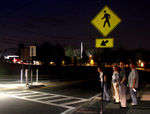Transportation Lighting Alliance Study Explores Pedestrian Safety at Roundabouts
 Roundabouts are becoming more and more common along our roads. These circular intersections can help ease traffic flow and reduce the severity of accidents, but they can also present some challenges to drivers and pedestrians, because they are still relatively new. Pedestrian crosswalks aren’t always in their familiar locations, and drivers may not always know where to look for pedestrians waiting to cross the roundabout. Lighting, both on vehicles and mounted on poles around the roundabout, can be important tools for pedestrian safety at roundabouts.
Roundabouts are becoming more and more common along our roads. These circular intersections can help ease traffic flow and reduce the severity of accidents, but they can also present some challenges to drivers and pedestrians, because they are still relatively new. Pedestrian crosswalks aren’t always in their familiar locations, and drivers may not always know where to look for pedestrians waiting to cross the roundabout. Lighting, both on vehicles and mounted on poles around the roundabout, can be important tools for pedestrian safety at roundabouts.
This is the topic of the newest Transportation Lighting Alliance (TLA) report from the Lighting Research Center (LRC) at Rensselaer Polytechnic Institute. LRC senior research scientist John Bullough and senior research specialist Nicholas Skinner compared pedestrian visibility under different lighting conditions in a two part study. They first used photometric lighting simulations to estimate the visibility of pedestrians by drivers in lighted and unlighted areas. Their analyses included conventional static headlamp systems found on most cars today, as well as advanced headlamp technologies that might be more common on cars of tomorrow. These included high-intensity discharge (HID) headlamps with wider patterns, and intelligent headlamps that could swivel toward pedestrians or other hazards to make them more visible.
 Bullough and Skinner estimated visibility using the relative visual performance (RVP) model. RVP predicts the speed and accuracy of seeing as a function of light level, target contrast, size and driver age. Although they found that some combinations of headlamps and roadway lighting reduced the contrast between pedestrians and their backgrounds, making them harder to see, they also found that HID and intelligent headlamps helped maintain high contrast and high visibility whether roadway lighting was present or not.
Bullough and Skinner estimated visibility using the relative visual performance (RVP) model. RVP predicts the speed and accuracy of seeing as a function of light level, target contrast, size and driver age. Although they found that some combinations of headlamps and roadway lighting reduced the contrast between pedestrians and their backgrounds, making them harder to see, they also found that HID and intelligent headlamps helped maintain high contrast and high visibility whether roadway lighting was present or not.
To then find out whether the RVP calculations had practical value, the LRC researchers conducted a nighttime field experiment, re-creating the virtual environments they studied in a real-world setting. The experimental targets were plywood silhouettes of a toddler, named 'Teela' in honor of the TLA. Study participants viewed a display screen and, when signaled, were asked to look up along the outdoor scene for Teela and identify whether she was walking toward the left or right. Computers recorded the participants response times. Bullough and Skinner found that the measured response times were highly correlated with the calculated visibility values using the RVP model. The correlation suggests that photometric simulations can be used to assess the practical value of new forms of vehicle headlamps in combination with roadway lighting.
Publications
Bullough, J. D. and N. P. Skinner. 2012. "Benefits of intelligent headlamp technologies to pedestrian safety at roundabouts." ![]() Transportation Lighting Alliance Report. Troy, NY.
Transportation Lighting Alliance Report. Troy, NY.
Sponsors
Transportation Lighting Alliance


